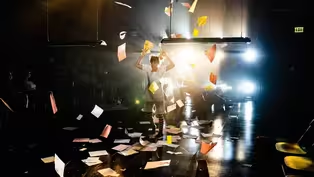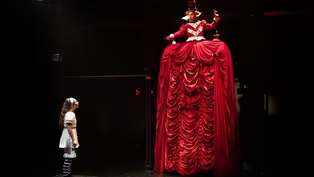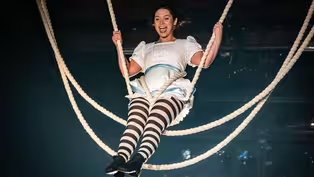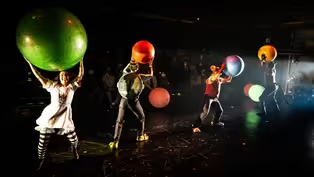
The Origins of Lookingglass Theatre and Lookingglass Alice
Clip: Season 1 | 4m 6sVideo has Closed Captions
A brief journey through the creation of "Lookingglass Alice," featuring David Schwimmer.
A brief journey through the creation of "Lookingglass Alice," featuring David Schwimmer.
Problems playing video? | Closed Captioning Feedback
Problems playing video? | Closed Captioning Feedback

The Origins of Lookingglass Theatre and Lookingglass Alice
Clip: Season 1 | 4m 6sVideo has Closed Captions
A brief journey through the creation of "Lookingglass Alice," featuring David Schwimmer.
Problems playing video? | Closed Captioning Feedback
How to Watch Lookingglass Alice
Lookingglass Alice is available to stream on pbs.org and the free PBS App, available on iPhone, Apple TV, Android TV, Android smartphones, Amazon Fire TV, Amazon Fire Tablet, Roku, Samsung Smart TV, and Vizio.
Providing Support for PBS.org
Learn Moreabout PBS online sponsorshipWhiting: Our "Alice" explores the tension between the rush we feel when we're younger to grow and go out into the world and the wisdom that we gain when we're older, hopefully, that growing up is not something to be rushed but cherished, and it all came out of the brilliant mind of ensemble member David Catlin.
My first question is why this story, or why the "Alice" stories?
Back a billion years ago when we were in college-- At the beginning of time.
At the beginning of time, a bunch of us were in an acting class together, and one of the people in the acting class was a guy named David Schwimmer.
In 1987, I was a student at Northwestern University in Chicago, and I had just directed this production of "Alice in Wonderland," this original adaptation by Andre Gregory and the Manhattan Project, a very physical production with 6 actors.
I produced it off campus with my own money, my Bar Mitzvah savings, and it became a little cult hit.
Next thing we knew, that summer, we went to the Edinburgh Fringe Festival and performed for two weeks.
It was a life-changing experience and, I think, one of the great reasons that we're here now as a theater company on Michigan Avenue in the city of Chicago 35 years later.
At Lookingglass, when we're doing proposals for plays, as you know, we ask the question why does the story need to be told, and why do I need to tell it?
We thought it would be great to potentially return to these "Alice" stories that Schwimmer had introduced us to.
Right about the time that this is happening, I had just become a father myself.
I was struck by how important each stage in life is, right?
The story is a lot about growing up and in a way reminding ourselves what to avoid about growing up and what to hold on to.
Alice steps through the looking glass and falls down a rabbit hole, and falling down the rabbit hole, there is-- which any expectant parent can recognize-- there is a sound in there, as she's falling into Wonderland after she's kind of had this long, floating experience in the Sea of Tears, which feels very amniotic to me.
Mm-hmm.
She's coming down, and in the soundscape is this "Wah, wah, wah" sound that is an actual fetal heartbeat.
[Fetal heartbeat] [Waves crashing] ♪ When she lands there, she meets the White Queen and the Red Queen, who are scaled at the kind of ratio that an infant looking up at their parent out of the crib might feel, and you have the dialogue of the play.
The conversation is between rational and irrational behavior, the White Queen representing the beauty of irrational thought, you know, like, the idea, to me, many of the important things in life, like staring at the moon and eating ice cream and riding on roller coasters and owning dogs, that's all irrational.
Right.
Doesn't make sense.
Yeah.
Doesn't make sense but deeply important, and we need the rational argument, as well, that the Red Queen presents, and so we have this conversation that's looming over Alice, and then, you know, one of the first squares she steps into is the Caterpillar square, and to me, the Caterpillar is the larval stage of becoming a butterfly, that it's all legs and questions.
How, how, how, why?
Catlin: That to me was the toddler stage.
Oh, yes.
I--even before he saw the show, I was like, "How does he know that scene?
"He's doing exactly that scene of, like, 'What, what, what, what?'"
I was like, "Catlin knew what he was doing, man.
That's a toddler."
Video has Closed Captions
Preview: S1 | 30s | 'Lookingglass Alice' is an exciting acrobatic adaptation of 'Alice In Wonderland.' (30s)
The Origins of Lookingglass Theatre and Lookingglass Alice
Video has Closed Captions
Clip: S1 | 4m 6s | A brief journey through the creation of "Lookingglass Alice," featuring David Schwimmer. (4m 6s)
Video has Closed Captions
Clip: Ep1 | 5m 2s | Alice meets the Mad Hatter and March Hare. (5m 2s)
Video has Closed Captions
Clip: Ep1 | 4m 31s | Alice starts her journey to a new world going down the rabbit hole. (4m 31s)
Video has Closed Captions
Clip: Ep1 | 4m 10s | Alice (Molly Hernandez) celebrates becoming a Queen at the acrobatic Coronation Ball. (4m 10s)
Providing Support for PBS.org
Learn Moreabout PBS online sponsorshipSupport for PBS provided by:
















